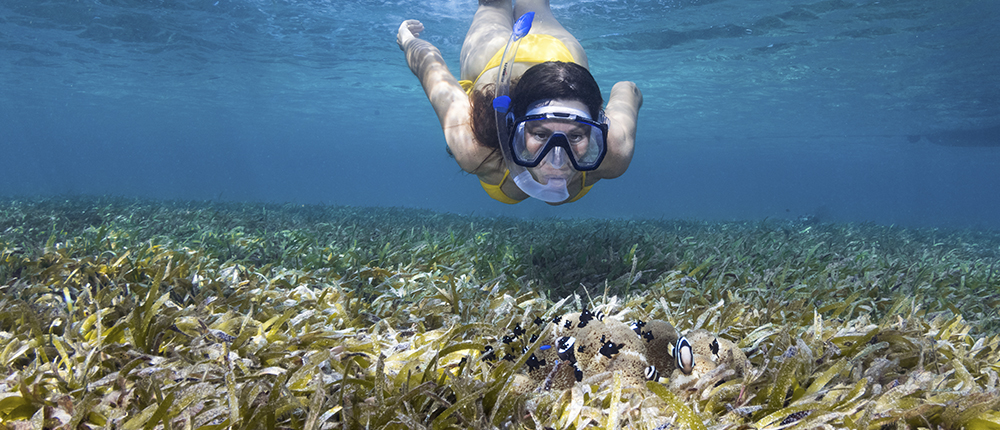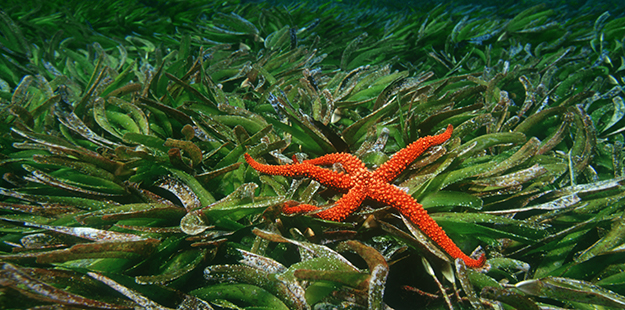A Kick in the Grass
Unique discoveries await those who snorkel into the seagrass beds at Wakatobi Resort
The reefs around Wakatobi Resort are ideal for snorkelers, as coral formations at many sites rise to within a meter or less of the surface. Dive boats provide daily access to dozens of these sites, but unique adventures can be found much closer to the resort. The shallows close to shore are often ignored by divers and snorkelers finning their way towards the outer edge of the House Reef. But those who pause to explore the seagrass beds that begin right at the low tide mark will discover an intriguing environment with a unique cast of characters.
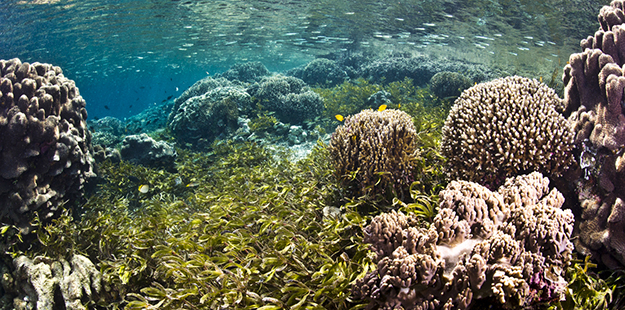
Seagrasses grow at depths where there is plenty of sunlight and clear water, such as what is found in the resort’s ‘front lawn’ just off the beach. Photo by Warren Baverstock
A visit to the front lawn
A visit to Wakatobi’s seagrass meadows is best done at mid to high tide, when there will be a meter or more of water covering this expanse of greenery. It wouldn’t be wrong to say that this area is the resort’s underwater front lawn, because the plants that grow here share commonalities with the grasses that keep suburbanites busy with lawnmowers. Seagrasses first came from the land, and though they have evolved for life underwater, they exhibit similar patterns of roots, stalks and leaves, and produce flowers and seeds. Because they draw energy from the sun for photosynthesis, seagrasses grow only at depths where there is ample sunlight and relatively clear water.
…it’s estimated that an acre of seagrass can support upwards of 40,000 fish and many thousands (perhaps millions) of small invertebrates.
Seagrass beds are among the most productive environments in the ocean. Some have even called them the underwater equivalent of a rainforest, in terms of biodiversity. These grass beds act as shelters for juveniles of many species, and provide a permanent habitat for many more. In fact, it’s estimated that an acre of seagrass can support upwards of 40,000 fish and many thousands (perhaps millions) of small invertebrates. Grasses mitigate currents that might otherwise wash away tiny creatures, and stabilize the sea floor to allow small burrowers to hide among grass roots, where they are less likely to be uncovered by foraging bottom feeders. Grasses are also an important food source, and an acre may produce as much as ten tons of leafs a year. This biomass not only becomes fodder for grazers, it also breaks down into edible detritus and sedentary nutrients when dead leaves are shed and set adrift.
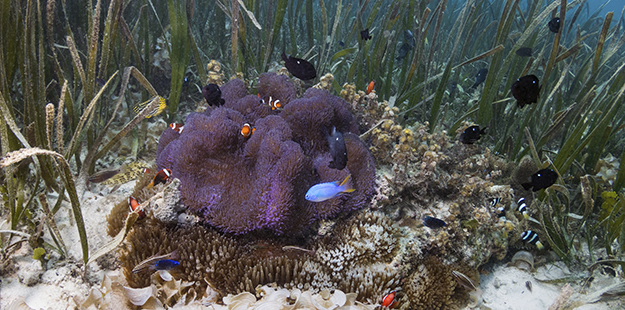
A wealth of small species and juvenile fish inhabit the seagrass beds. In this small area are several species of clownfish, damselfish and wrasses. Photo by Walt Stearns
The small stuff
An up-close study of Wakatobi Resort’s seagrass beds will reveal a wealth of small creatures. For starters, there are the juvenile fish, as well as many species of damselfish and wrasses, including small parrotfish. Keen-eyed snorkelers may see through the camouflage of a drifting pipefish, or zero in on a colorful nudibranch or slow-moving slug. Rocks or areas of harder bottom that discourage root growth may be colonized by anemones and their attendant clownfish, while sand patches may hold hidden burrowers such as snake eels, which can often be identified only by a pair of eyes that barely protrude from the surrounding sediment.
“The volume of fish and wildlife generally just under the surface and around the front of the resort has been amazing,” says guest John Pratt. “We loved just wading in right from the villa steps, having it all right there at your doorstep,” adds Barbara Pratt.
Some of the most fascinating small finds are the crabs—especially the decorators and pom-poms. In much the same way as human snipers attach leaves and branches to a ghillie suit to blend into the background, decorator crabs will adorn themselves with bits of seaweed, sponge and marine detritus to escape detection. Pom-pom crabs embrace a different strategy, forgoing camouflage in favor of biological weaponry. This small crab will cultivate an even smaller live anemone on each of its claws, and when it brandishes these stinging add-ons, it resembles nothing so much as a cheerleader brandishing a colorful pair of pom-poms.
Hypnotic predators
One of the most intelligent and fascinating predators in the ocean can sometimes be spotted prowling through Wakatobi’s seagrass beds. Cuttlefish are a favorite subject of photographers and fish watchers alike, due to this animal’s amazing ability to rapidly change the colors and patterns of its skin. The sight of one of these streamlined cephalopods strobing like a Las Vegas marquee can be mesmerizing, and at times, a cuttlefish will light up in ways that literally hypnotize its prey into immobility.
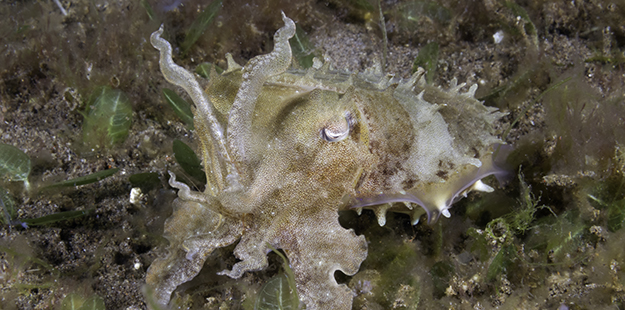
Cuttlefish use their keen eyesight to detect quarry such as shrimp and crabs that hide among the seagrass stalks. Photo by Walt Stearns
Hypnotic light shows are more likely to occur on the reef near dawn or dusk, but cuttlefish also hunt in the shallows, where they employ a different strategy. Here, they can be found cruising close to the sand, using their excellent eyesight to detect quarry such as shrimp and crabs that are attempting to hide among the seagrass stalks. They can also root out small animals buried in the sand by exhaling a strong jet of water that uncovers their prey. Once it locks on to a potential meal, a cuttlefish can strike very quickly, deploying a pair of feeding tentacles to draw the prey into its enveloping arms. Suction pads immobilize the unfortunate captive while it receives a dose of paralyzing toxin, then it is drawn into the cuttlefish’s sharp beak. Maybe it’s a good thing that these animals don’t grow much larger than 25 cm (10 inches), or you might not want to go for a swim.
The graceful hunter
Mixed in with all the tiny creatures that hide among the grasses is a mid-sized cast of characters that can provide hours of fish-watching enjoyment. One that is often seen gliding through the grass beds is the bluespotted stingray. This is one of the smaller members of the ray family, with adults having wingspans of around 45 cm (18 inches). Most of the rays found on the grass beds will be smaller, as this is a favorite area for youngsters. The distinctive blue spots that decorate the ray’s upper flanks make it easy to identify, and serve as a warning to would-be predators, as the bluespotted packs a venomous punch in its long, barbed tail.

Bluespotted stingrays are a common sight in the grass beds at Wakatobi as they move about the in search of food or a cleaning station. Photo by Kristina Vackova
In addition to being easily recognized, bluespotted rays usually remain in plain sight, as they don’t tend to bury themselves in the sand, and instead spend much of their time swimming close to the bottom, using their wide-set eyes to search for the next meal. It can be entertaining to spend a few minutes following this graceful little hunter around as it glides through the grass in search of small fish, shrimp, crabs or mollusks. Once a suitable meal is located, the bluespotted ray will swoop in to pin the prey to the bottom with its wings. Once the meal is immobilized, the ray can get right to feeding, using its strong jaws and crushing teeth that are located on the bottom side of the body. You may also encounter bluespotted rays moving between the grass beds and the coral heads of the House Reef. They are likely looking for a cleaning station, as these rays are often plagued by parasites such as tapeworms, flatworms and flukes.
Armor-plated gardeners
Green sea turtles are also frequent visitors to the grass beds of Wakatobi. For many of these animals, it could be a homecoming, as the adjacent beach is a favorite nesting site, and for many years the resort operated a turtle nursery program. But it’s not nostalgia that draws these well-armored grazers, but rather the chance to chew on some tender seagrass. Green sea turtles are one of the few large aquatic herbivores that feed on the grasses, and their grazing represents a benefit rather than a threat to the plants.


